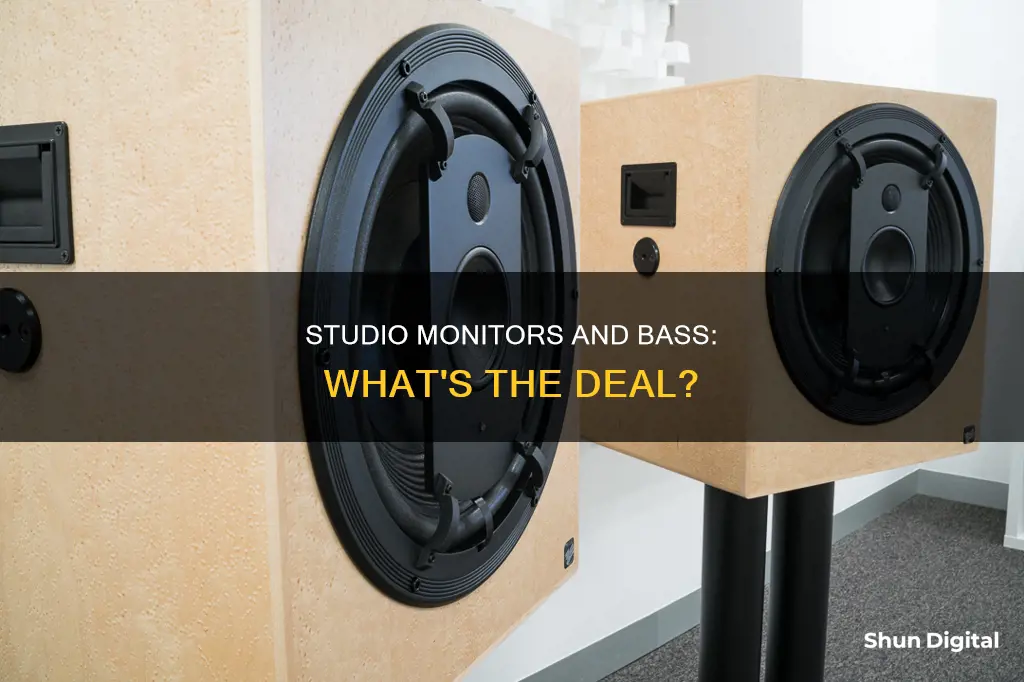
Studio monitors are designed to provide an accurate, uncoloured representation of music. However, some users have reported that their studio monitors lack bass. This could be due to the monitor model, the room's acoustics, or the monitor's position in the room. To compensate, some producers use subwoofers or larger monitors to extend the low-end response, but this may not be suitable for all spaces. The addition of a subwoofer can introduce issues with standing waves and phase cancellation in small rooms, resulting in an inaccurate bass response. Therefore, acoustic treatment with bass traps and careful monitor placement are crucial to achieving accurate bass reproduction.
| Characteristics | Values |
|---|---|
| Studio monitors have bass | Yes, but the amount of bass depends on the monitor and the room they are in. |
| Need for a subwoofer | Depends on the space and the type of work being done. |
| Bass levels | Can be adjusted using a switch at the back of the monitor. |
| Monitor placement | Affects the amount of bass heard. |
| Room acoustics | Can cause issues with standing waves and phase cancellation. |
| Bass traps | Can be used to improve room acoustics and reduce standing waves. |
| Headphones | Can be used as a reference for low-end frequencies. |
What You'll Learn

Studio monitors and their bass capabilities
Studio monitors are designed to offer an accurate and precise representation of music, revealing every detail in a mix across the entire frequency range. While they do produce bass, the bass capabilities of studio monitors can vary depending on factors such as size, placement, and the acoustics of the room.
The bass response of studio monitors is influenced by their size. Smaller studio monitors tend to have limited bass extension, often rolling off before reaching the lowest frequencies. For example, 5-inch monitors typically have a low-frequency response down to about 50Hz. Upgrading to larger monitors with 8-inch drivers can provide improved bass capabilities, extending the response down to approximately 35Hz. This allows for a better representation of lower bass frequencies.
The placement of studio monitors can also impact their bass performance. It is recommended to position studio monitors in an equilateral triangle with the listener's head for the most accurate frequency response. However, moving away from this ideal position can result in variations in bass response due to the creation of standing waves in the room. Stepping back from the monitors can lead to experiencing a sudden increase in bass, which is caused by the interaction of sound waves reflecting off the walls.
Additionally, the acoustics of the room play a crucial role in the bass capabilities of studio monitors. Small rooms, particularly those with parallel walls, can result in issues such as standing waves and phase cancellation, leading to an uneven bass response. Acoustic treatment, such as bass traps, can help mitigate these issues by absorbing low-frequency energy and reducing reflections. Without proper acoustic treatment, the bass response in the room may be inaccurate, affecting the ability to mix and produce music effectively.
In summary, while studio monitors do produce bass, their bass capabilities can be influenced by various factors. The size of the monitors, their placement in the room, and the acoustics of the space all contribute to the overall bass response. Acoustic treatment and careful positioning can help optimize the bass performance of studio monitors, ensuring a more accurate representation of the lower frequencies.
Monitoring Call Center Performance: Strategies for Success
You may want to see also

Subwoofers and their effect on studio monitors
Studio monitors can reproduce some bass frequencies, but a subwoofer is specifically designed to handle the extreme low end of the frequency spectrum, providing a powerful and precise bass response. Subwoofers are loudspeakers designed to handle low-frequency sound waves, typically in the range of 20 to 200 Hz.
A subwoofer can be a great addition to a studio setup, aiding in the perception of bass content in tracks. They are particularly useful for electronic music producers, allowing them to accurately monitor the low end with pinpoint accuracy. The tactile response of a subwoofer allows producers to physically feel how the bass is interacting with the rest of the mix.
However, simply adding a subwoofer to a studio setup may not give the desired effect. Proper placement, calibration, and room treatment are crucial for a subwoofer to be beneficial. The size and shape of the room play a significant role in controlling low frequencies, and standing waves can be created that make it difficult to accurately perceive bass content. Acoustic treatment, such as bass traps, can help solve this issue.
Additionally, the way studio monitors interact with a subwoofer varies depending on the make, and it is important to match the right subwoofer to the right monitors. Factors such as room size, acoustic treatment, speaker placement, and calibration must be considered to make a subwoofer effective in a studio setup.
In conclusion, while subwoofers can enhance the bass response of studio monitors, careful consideration and setup are necessary to ensure they provide accurate and beneficial results.
Kia Sportage Trim Levels: Blind Spot Monitor Options
You may want to see also

The impact of room acoustics on bass
The dimensions of a room, including its width, length, and height, can boost or dampen specific sound frequencies, resulting in a unique acoustic character. In smaller spaces, sound waves reflect off surfaces rapidly, creating a "boxy" or distorted sound, especially for low-frequency sounds, which may seem disproportionately loud. Larger rooms, on the other hand, may exhibit issues such as echo, reverberation, uneven sound distribution, and bass accumulation.
To address bass issues in smaller rooms, strategic placement of bass traps is crucial. Targeting corners and wall-ceiling junctions with broadband bass traps can help intercept low-frequency sound waves and prevent acoustic issues. In larger rooms, scaling up bass traps in size or quantity can provide adequate absorption. Additionally, the use of Helmholtz resonators can offer targeted absorption within specific frequency bands.
The materials used within a room also play a vital role in bass response. Soft, porous, and lightweight materials, such as acoustic panels, fabric-wrapped panels, and acoustical foam, can help absorb sound vibrations and improve bass clarity. Conversely, hard and smooth surfaces like glass, concrete, or hardwood floors tend to reflect sound, potentially leading to echoes and a harsh sound quality.
Furthermore, the shape of a room influences sound behaviour. Rooms with parallel surfaces can create standing waves, resulting in certain frequencies being amplified or suppressed. To optimise bass response, custom solutions may be required, including tailored acoustic treatment plans and custom bass traps designed to fit the room perfectly.
In summary, understanding the impact of room acoustics on bass is essential for achieving optimal sound quality. By selecting the right bass traps, strategically placing them, and considering custom solutions, a balanced and natural sound environment can be created, enhancing the overall listening experience.
Blind Spot Monitoring: CX-3's Safety Feature
You may want to see also

Bass traps and their function
Bass traps are acoustic energy absorbers designed to reduce low-frequency sound energy, with the goal of achieving a flatter low-frequency room response. They are commonly used in recording studios, home theatres, and other rooms built for critical listening.
There are two main types of bass traps: resonant absorbers and porous absorbers. Resonant absorbers are mechanically tuned to resonate with the frequencies being absorbed, while porous absorbers do not resonate and do not need to be tuned. Porous absorbers are smaller, easier to design and build, and less expensive, but their deep bass attenuation is inferior. Resonant absorbers absorb a narrower spectrum, while porous absorbers absorb a broader spectrum.
Resonant bass traps include rigid containers with portholes or slots (Helmholtz resonators) and rigid containers with flexible diaphragms (membrane absorbers). Resonant absorbers vary in construction, with some using a springy sheet of wood attached only at the edges, and others using a floppy sheet of thin material stretched like a drumhead.
Porous bass traps are typically made from fibreglass, mineral wool, or open-cell foam, which resists the passage of air molecules. They are often covered with a porous fabric similar to speaker grill cloth. Porous traps need to be very thick to be effective at lower frequencies, so they are usually placed diagonally in corners or as thick rectangles behind false walls.
The ideal placement for bass traps is in the corners of the room. If using porous bass traps, it is important to leave some empty space between the traps and the corners. For resonant absorbers, they should be placed directly into the corners, against the walls, as this is where sound pressure builds up the most.
Bass traps are essential for achieving clean and accurate sound in a room. They address room modes, which are a collection of resonances created by the interaction of sound waves with reflective surfaces. Bass traps can help eliminate or reduce this reflection, resulting in a clearer representation of the audio.
Finding the Studio Monitor Sweet Spot: Where to Place Your Speakers
You may want to see also

Headphones for referencing bass
Reference headphones are a vital tool for audio engineers and producers to ensure a mix is balanced and free of imperfections. When referencing bass, it's important to use headphones that provide an accurate representation of the low-end frequencies. Here are some recommendations and tips for choosing headphones for referencing bass:
Choosing the Right Headphones
When selecting headphones for referencing bass, look for models that offer a flat frequency response, also known as a "studio" or "reference" sound signature. These headphones aim to reproduce audio as accurately as possible, without adding any colouration or emphasis on certain frequencies. This is crucial for identifying and fixing issues in your mix. Here are some specific headphone models recommended for referencing bass:
- Shure SRH940: These headphones are designed for critical listening and mastering, offering a wide soundstage and accurate, flat response.
- Shure SRH1440 and SRH1840: Open-back headphone models that provide a spacious soundstage and detailed, accurate sound.
- Sony WH-1000XM4 Wireless: While these headphones have a bass-heavy sound profile, they also offer a graphic EQ and presets to customise the sound to your needs.
- Sony ULT WEAR Wireless: These headphones offer a boomy, thumpy sound, with an extra bass boost feature for up to three levels of low-end enhancement.
- Skullcandy Crusher Evo Wireless: Featuring a haptic bass slider, these headphones allow you to add extra vibrations to your audio for an intense bass experience.
- Anker Soundcore Life Q30 Wireless: These headphones offer a bass-heavy sound profile and a companion app with a graphic EQ and presets for customisation.
- Sennheiser MOMENTUM True Wireless 3: These earbuds provide a bass-rich sound profile and a companion app with EQ and presets for personalisation.
- Pioneer DJ HDJ-CUE1BT Wireless: These on-ear headphones are designed for DJs, offering a thumpy, rumbly bass response with excellent mid-frequency reproduction.
Tips for Using Headphones for Bass Referencing
When using headphones for referencing bass, keep the following tips in mind:
- Listen for noise issues like hiss and hum, which are more easily identified with headphones. Use noise reduction techniques or EQ adjustments to address these issues.
- Identify and reduce compression artifacts like "pumping" and "breathing" by adjusting compression settings on the affected tracks.
- Pay close attention to reverb and delay/echo effects, as headphones can reveal subtle details that may be less noticeable on other monitoring systems. Adjust these effects as needed to ensure they complement the song.
- Listen for distorted or harsh-sounding transients, which may indicate clipping or overdriven hardware. Adjust input and output levels to resolve these issues.
- Use headphones to identify pops and clicks caused by improper editing or equipment adjustments, and apply fades or use a drawing tool to reshape the waveform.
- Judge the amount of low-end frequency buildup or resonance in your mix, and use a high-pass filter to remove excessive low frequencies while preserving important lower harmonics.
Monitoring ETF Performance: Strategies for Success
You may want to see also
Frequently asked questions
Studio monitors can have lower bass than other speakers, and you may need to add a subwoofer to extend the low end.
You can adjust the bass levels on your studio monitors, or add a subwoofer to your setup. However, adding a subwoofer will only help if you have the right space, as small rooms can cause issues with standing waves and phase cancellation.
You should place your studio monitors so that they form an equilateral triangle with your head when you are seated in your mix position. This will result in the most accurate frequency response and clearest stereo image.







